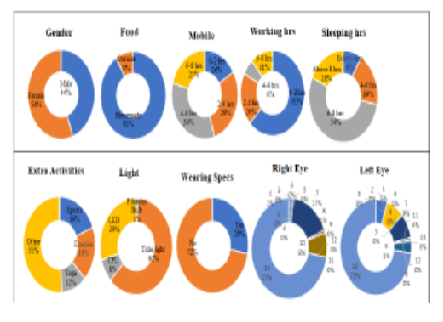


Indian Journal of Science and Technology
DOI: 10.17485/IJST/v16i17.1308
Year: 2023, Volume: 16, Issue: 17, Pages: 1250-1259
Original Article
G Gopi1*, T Edwin Prabakaran2
1Research Scholar, Department of Statistics, Loyola College, Chennai, 600034, Tamil Nadu, India
2Associate Professor, Department of Statistics, Loyola College, Chennai, 600034, Tamil Nadu, India
*Corresponding Author
Email: [email protected]
Received Date:21 June 2022, Accepted Date:26 March 2023, Published Date:28 April 2023
Objectives: To compare the results of techniques Decision Tree, Discriminant, KNN, SVM applied to pre Covid-19 data collected in 2018 and data collected during Covid-19 pandemic period (2020) patients in Chennai city. Methods: The variables in the data are Refractive Error in both left and right eye, Age, Gender, Educational Status, Employment Status, Nature of Job, Working Hours, Working with Computer, Watching TV, Sleeping Hours, Type of Food, Extra Activity, Light in Residence, Light in Work Place, Family Members Wearing Specs, Parents Wearing Specs, Other Disease and Other eye disease. Findings: In this study, 22 classification algorithms were applied to the data, and accuracy results as well as comparisons in two distinct sample sizes were obtained. Although adhering to the strict lockdown regulations helps to prevent the spread of COVID-19, it also negatively affects the visual health of those who are confined to their homes and have limited access to outdoor activities, leading to an excessive confidence on digital screens for studies or leisure. Novelty: Due to public health restrictions, the present Covid 19 pandemic has altered people’s social lives all around the world. As a result, kids have spent more time in front of computer and television monitor screens, which is bad for their eyes. Refractive error affects a significant number of patients in Chennai. Across all kinds of refractive defects, myopia, hyperopia, astigmatism, and presbyopia constitute the most prevalent.
Keywords: Covid19; Refractive error; KNN; SVM; Decision Tree; Discriminant
© 2023 Gopi & Prabakaran. This is an open-access article distributed under the terms of the Creative Commons Attribution License, which permits unrestricted use, distribution, and reproduction in any medium, provided the original author and source are credited. Published By Indian Society for Education and Environment (iSee)
Subscribe now for latest articles and news.